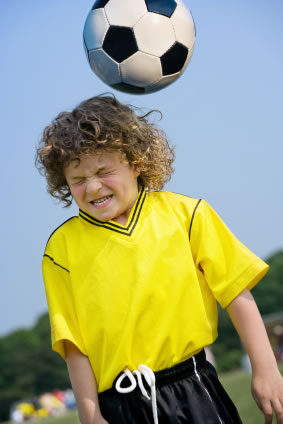
istockphoto
- Researchers used diffusion tensor imaging to determine if heading a soccer ball could cause brain injury.
- Players who most frequently headed the ball exhibited abnormalities in five brain regions.
- Players who headed the ball at least 1,000 to 1,500 times per year showed detectable white matter injury.
Heading, in which players field the soccer ball with their head, is an essential part of the game and the focus of many training drills.
“Heading a soccer ball is not an impact of a magnitude that will lacerate nerve fibers in the brain,” said Michael L. Lipton, M.D., Ph.D., associate director of the Gruss Magnetic Resonance Research Center at the Albert Einstein College of Medicine and medical director of MRI services at Montefiore Medical Center in New York. “But repetitive heading could set off a cascade of responses that can lead to degeneration of brain cells.”
DTI, an advanced magnetic resonance (MR) technique, allows researchers to assess microscopic changes in the brain’s white matter, which is composed of millions of nerve fibers called axons that act like communication cables connecting various regions of the brain. DTI produces a measurement, called fractional anisotropy (FA), of the movement of water molecules along axons. In healthy white matter, the direction of water movement is fairly uniform and measures high in FA. When water movement is more random, FA values decrease.
“Abnormally low FA within white matter has been associated with cognitive impairment in patients with TBI,” Dr. Lipton said.
Dr. Lipton and colleagues conducted DTI on 32 amateur soccer players (average age: 30.8 years), all of whom have played the sport since childhood. The researchers estimated how often each soccer player headed the ball on an annual basis and then ranked the players based on heading frequency. They then compared the brain images of the most frequent headers with those of the remaining players and identified areas of the brain where FA values differed significantly.
“Between the two groups, there were significant differences in FA in five brain regions in the frontal lobe and in the temporooccipital region,” Dr. Lipton said. “Soccer players who headed most frequently had significantly lower FA in these brain regions.”
The five regions identified by the researchers are responsible for attention, memory, executive functioning and higher-order visual functions.
To assess the relationship between the frequency of heading and white matter changes, the researchers also compared the magnitude of FA in each brain region with the frequency of heading in each soccer player.
“Our goal was to determine if there is a threshold level for heading frequency that, when surpassed, resulted in detectable white matter injury,” Dr. Lipton said.
The analysis revealed a threshold level of approximately 1,000 to 1,500 heads per year. Once players in the study surpassed that level, researchers observed a significant decline in their FA in the five identified brain regions.
“What we’ve shown here is compelling evidence that there are brain changes that look like traumatic brain injury as a result of heading a soccer ball with high frequency,” Dr. Lipton said. “Given that soccer is the most popular sport worldwide and is played extensively by children, these are findings that should be taken into consideration in order to protect soccer players.”
Coauthors are Namhee Kim, Ph.D., Molly Zimmerman, Ph.D., Richard Lipton, M.D., Walter Stewart, Ph.D., Edwin Gulko, M.D., and Craig Branch, Ph.D.
Source: RSNA
